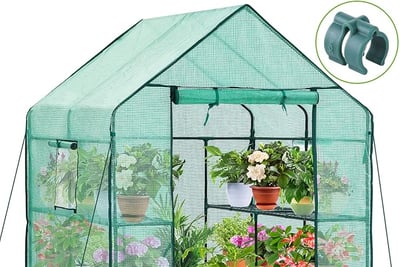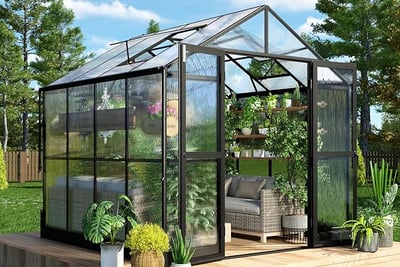How to Build a Simple DIY Greenhouse for Winter Gardening
5 min read


Understanding the Benefits of a Greenhouse
Gardeners increasingly recognize the advantages of utilizing a greenhouse for winter gardening. A greenhouse serves as a controlled environment that can shield plants from the harsh winter cold, strong winds, and unpredictable weather conditions. This protective structure maintains a consistent temperature, facilitating healthy growth during seasons when outdoor gardening is often unfeasible. By regulating the internal climate, gardeners can cultivate a variety of plants that would otherwise perish under frosty conditions.
One significant benefit of a greenhouse is its ability to extend the growing season. With this structure, gardeners can initiate planting earlier in the spring and continue growing later into the fall, allowing for a diverse array of crops throughout the year. Furthermore, many greenhouses are equipped with supplemental lighting and heating systems, which can enhance plant growth by providing sufficient light and warmth even during the shorter days of winter. This extension not only promotes a continuous supply of fresh produce but also enables gardeners to experiment with different plant varieties.
Additionally, increased plant yield is a notable advantage of using a greenhouse. By creating an enclosed environment, gardeners can optimize conditions for each plant species, enabling them to flourish. This controlled setting reduces the risk of pests and diseases, which are often problematic in traditional outdoor gardens. Moreover, the greenhouse can facilitate the application of hydroponic or aquaponic systems, leading to more efficient water usage and further enhancing plant productivity.
There are various types of greenhouses available, each offering unique benefits tailored to different gardening needs. From small, portable designs to large, permanent structures, aspiring gardeners can choose an option that best fits their space and budget. Investing time and resources into building a greenhouse can significantly enrich the winter gardening experience, providing an opportunity to enjoy fresh vegetation even in the coldest months.
Essential Materials and Tools for Your Greenhouse
When embarking on the journey of constructing a DIY greenhouse for winter gardening, the selection of appropriate materials and tools is paramount for ensuring both durability and functionality. There are several options available for the frame of the greenhouse, each with its own advantages and disadvantages.
Wood is a popular choice for greenhouse frames due to its natural aesthetic appeal and availability. Pressure-treated lumber is especially favored for its resistance to decay, making it suitable for outdoor conditions. However, wood can be susceptible to rot and insect damage if not properly maintained. An alternative is the use of PVC pipes, which are lightweight and resistant to corrosion and rot. They are relatively inexpensive and easy to work with, yet they may not provide as much structural strength as metal or wood frames. If you require a sturdy and long-lasting option, metal frames—such as aluminum or galvanized steel—are highly durable and offer excellent wind resistance, though they can be more expensive and heavier to handle.
Next, greenhouse covering materials significantly impact temperature regulation and light penetration. Polyethylene film is commonly used due to its affordability and effective insulation properties; however, it may need replacement every few years. Glass panels provide excellent light transmission and aesthetics but are more costly and can break easily. Polycarbonate panels, available in twin-wall or single-wall varieties, offer a balance between durability and insulation, making them suitable for diverse climates. Selecting the right covering material should consider both budget and environmental conditions.
Before commencing your greenhouse assembly, ensure that you have the necessary tools and equipment on hand. Basic tools required include a saw, drill, measuring tape, and level, complemented by safety gear such as gloves and goggles. Additionally, fastening materials—like screws, brackets, and hinges—will facilitate assembly. Having these essential materials and tools readily available will streamline the construction process and ensure a reliable greenhouse structure.
Step-by-Step Instructions for Building Your Greenhouse
Constructing a simple DIY greenhouse for winter gardening can significantly enhance your gardening capabilities. To begin, select a location that receives ample sunlight and is shielded from harsh winds. Ideally, a south-facing spot is best for maximizing solar gain, especially during the colder months. Once a suitable area is chosen, prepare the site by clearing debris and leveling the ground to create a stable foundation for your greenhouse.
The next step involves constructing the frame. Depending on your design—whether you prefer wood, PVC, or metal—ensure that the materials are durable and weather-resistant. Begin by taking accurate measurements to ensure everything fits together seamlessly. Cut the materials according to your planned dimensions and assemble the frame, securing all joints with screws or brackets to enhance stability. It is advisable to use bolts for larger frames to withstand the weight of snow in winter.
Once the frame is complete, it's time to install the covering materials. Polyethylene sheeting is a popular choice due to its affordability and lightweight nature, but consider using polycarbonate panels for added durability. Ensure that you attach the covering securely to prevent it from being blown away or compromised by winter storms. Proper sealing around the edges will also help retain heat within the greenhouse.
Ventilation is a crucial element in maintaining a healthy environment inside your DIY greenhouse. Incorporate small windows or vents that can be opened, allowing excess heat to escape during sunny days. Automated vent openers can be beneficial, ensuring consistent airflow without constant manual adjustments. Regularly inspect and maintain your greenhouse's structural integrity, especially after severe weather events, to ensure it remains robust throughout the winter gardening season. Visual aids such as illustrations or diagrams can provide helpful insights during the construction process, making each step straightforward and understandable.
Tips for Maintaining Your Greenhouse During Winter
Maintaining a greenhouse through the winter months is crucial for ensuring a successful growing season. It begins with closely monitoring temperature and humidity levels inside your greenhouse. Installing a reliable thermometer and hygrometer can help track these variables effectively. Aim to maintain a consistent temperature between 65°F and 70°F during the day and no lower than 60°F at night. If your greenhouse lacks adequate heating, consider using electric heaters or heat mats to stabilize temperature and ensure a conducive growing environment.
Watering practices also require adjustments during winter gardening. Plants typically need less water during the colder months due to decreased evaporation rates and lower photosynthesis. It's essential to assess the moisture levels of the soil before watering; overwatering can lead to root rot, especially in the winter when plants are not actively growing. A moisture meter can be an invaluable tool for this purpose.
Pest management is another area of concern during winter. Although many pests become dormant in colder weather, it's important to remain vigilant. Regularly inspect plants for any signs of infestations, and if detected, treat them promptly using organic pest control methods to prevent them from spreading. Additionally, ensure adequate air circulation within the greenhouse to deter fungal diseases which can thrive in damp conditions.
Promoting light exposure for your plants is equally important. During winter, daylight hours are shorter, which can impede plant growth. Placing reflective surfaces around the greenhouse can help maximize light intake. Supplemental lighting, if feasible, can also enhance plant growth by providing the necessary light spectrum. As plants transition into the colder months, acclimatizing them to different temperatures by gradually introducing them to the greenhouse environment will further promote their health. Investing time and effort into these practices will ensure that your greenhouse remains an effective space for winter gardening.





